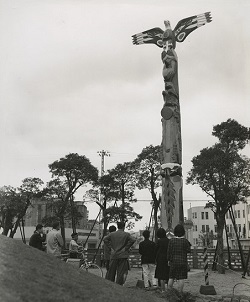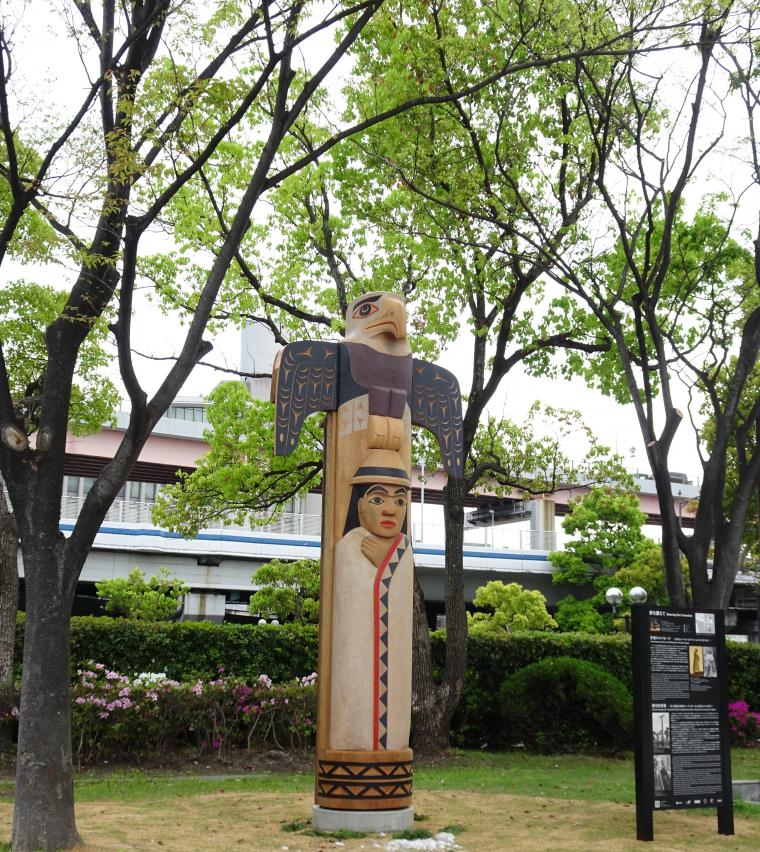ホーム > 市政情報 > 計画 > 市長室の計画・事業等 > 国際交流 > 神戸市の姉妹・友好・親善協力都市 > 姉妹都市:シアトル > The story of the story pole and totem pole from our sister city Seattle
The story of the story pole and totem pole from our sister city Seattle
ここから本文です。
A gift from the City of Seattle in 2024, this wooden sculpture is located near the Flower Clock in Chuo Ward. It is the successor to the first totem pole we received from our sister city.
Contents :
- Overview of the wooden sculptures from Seattle in Flower Clock Plaza
- What are totem poles and story poles?
- Chronological history of the totem pole and story pole in Kobe
- The first sculpture: The totem pole carved by Joseph Hillaire
- The second sculpture: The story pole carved by Qwalsius
- Related Links
Overview of the wooden sculptures from Seattle in Flower Clock Plaza
The first sculpture: totem pole

Name of work: Totem Pole
Year received: 1961
Artist: Joseph Hillaire (traditional name: kwul-kwul’tw) of the Lummi Nation, a Native American tribe of the Coast Salish people
Location: It originally stood in the former location of Flower Clock Plaza. Due to damage and deterioration, it was removed and now rests in the Kobe Arboretum, where it will slowly return to the earth.
The second sculpture: story pole

Name of work: Honoring Our Connection
Years created: 2022-2023
Year received: 2024
Artist: Qwalsius - Shaun Peterson of the Puyallup Tribe, a Native American tribe of the Coast Salish people. His Coast Salish traditional name is Qwalsius (qʷəlsius).
Location: South side of Higashi Yuenchi Park (south of the Flower Clock)
Location: South side of Higashi Yuenchi Park (south of the Flower Clock)
*Another totem pole, “Sea Bear” Gonagadet, also resides at the Kobe Arboretum.
What are totem poles and story poles?
Totem poles are wooden sculptures, typically several meters in height, carved by the Indigenous peoples of the Pacific Northwest in North America. However, “story pole” specifically refers to the wooden sculptures carved by the Coast Salish people. Although the sculpture carved by Joseph Hillaire is technically a story pole, at the time of its creation all such works were referred to as totem poles, so the work retains that moniker to this day.
Our second sculpture, carved by Qwalsius, is referred to as a story pole.
Chronological history of the totem pole and story pole in Kobe
| 1957 | Kobe and Seattle sign a sister-city partnership agreement. |
| 1961 | Joseph Hillaire completes his carving of the Totem Pole (Friendship Pole), which stands in the former location of Flower Clock Plaza. |
| 2015 | The Totem Pole is removed from the former Flower Clock Plaza. |
| 2017 | Seattle proposes offering a new wooden sculpture to Kobe, and commissions Qwalsius to carve it. Qwalsius visits Kobe for the 60th anniversary of the Kobe-Seattle sister city relationship, and during his stay the design concept and other details are discussed. |
| 2022 | For the 65th anniversary of the Kobe-Seattle sister city relationship, the gifting of the story pole and its design are announced. |
| 2023 | The story pole is carved in Seattle. |
| 2024 | The story pole is erected in Kobe. |
The first sculpture: The totem pole carved by Joseph Hillaire
In 1961, the people of Seattle and the City of Seattle commissioned Mr. Joseph Hillaire (traditional name: kwul-kwul’tw), a member of the Native American Lummi Nation, to carve an artwork to give to the people of Kobe. The gift was meticulously carved over the course of three months in Seattle, and the carver completed the totem pole in Kobe in October that year.The pole stood proudly outside Kobe City Hall for 54 years from 1961-2015. By 2015, because the totem pole had sustained extensive weather damage, it was removed and laid to rest in the Kobe Arboretum, in order to let it return to nature.
The second sculpture: The story pole carved by Qwalsius
The Seattle-Kobe Sister City Association, City of Seattle, and Port of Seattle commissioned Qwalsius (qʷəlsius) - Shaun Peterson, a local Seattle regional artist of the Native American Puyallup Tribe, to create a new gift to symbolize the future years of our Sister City and Sister Port relationship.
As Qwalsius learned about Joseph Hillaire’s gift to Kobe, and saw the original pole in Kobe in 2017, he developed his vision for this new sculpture, with the goal to acknowledge Joseph Hillaire’s work, and represent the Coast Salish artistic traditions that are an important legacy for both the Lummi Nation and the Puyallup Tribe. This gift is a symbol of connections – connections between our Sister Cities of Seattle and Kobe, between Coast Salish peoples in the Pacific Northwest and the Native peoples and Japanese people in Japan, and between all of us as people.
Artist Statement on the Coast Salish people’s connection to Japan
“It is an honor to be called upon to create a monumental work from the Seattle region to share with the people of Kobe. I bring my thirty years of cultural exploration, the artistic workmanship of the art of my tribe, and the influence of master artists before me to this project.
This sculpture features two figures. The woman wearing a wool blanket represents the connection to the land, and the resources that land provides for us. The wool blanket is a symbol of wealth and art within Coast Salish culture, similar to how a ceremonial kimono is in Japanese culture. The eagle overhead is used as a symbol of honor in Pacific Northwest art and has been a part of our tribal histories for many generations, as well as a strong symbol of the broader United States.
In a way, this new story pole is a short story to express how I had a brief stay in Kobe, and in that short time, a feeling of welcome remains. That will be part of a longer history and relationship, for me as an artist and culture bearer, and for the connection of our two cities.”